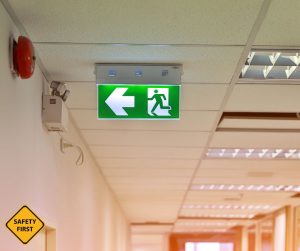Fire Safety Management
Suitable fire safety management in the workplace ensures that employees are familiar with evacuation procedures, designated escape routes, and the proper use of firefighting equipment, promoting a structured response if a fire were to break out.
In a workplace fire, even seemingly minor mistakes can lead to devastating consequences. There really is little room for error, as unlike other safety hazards, fire spreads rapidly. Similarly, because fires can erupt unexpectedly, it is vital to have a zero-tolerance approach to fire safety.
Below, we have outlined some common errors which can compromise the preparedness of your workplace, when it comes to fire safety.
Absence of a Comprehensive Fire Risk Assessment
Without an adequate fire risk assessment, your workplace may be exposed to many dangers. Unidentified fire hazards such as improper chemical storage or electrical issues can become ticking time bombs. A lack of suitable mitigation measures can endanger building occupants and causing property damage. In addition, fire safety regulations mandate proper fire risk assessments. In the absence of such an assessment, employers are leaving themselves vulnerable to legal repercussions.
iProtectU Risk Assessment Software takes the stress out of conducting fire risk assessments. With iProtectU, employers and managers can identify the most significant fire risks to the organisation, develop risk mitigation strategies and generate a comprehensive fire risk assessment report. Get in touch today to discuss our fire safety solutions.
Failure to consider Special Needs
Neglecting the needs of staff with disabilities during fire safety planning can have disastrous consequences. People with physical limitations may struggle to evacuate promptly using stairs and may need assistance.
In a similar way, people with hearing impairments may not hear fire alarms, while those with visual impairments may find it difficult navigating smoke-filled environments. Fire safety regulations don’t always fully address the needs of diverse workforces, which makes this a global concern.
If evacuation plans don’t consider these challenges, employees with disabilities are left vulnerable. Workplaces must proactively identify and address special needs, through a Personal Emergency Evacuation Plan (PEEP). This may involve designating evacuation buddies, having alternative escape routes which are accessible to wheelchairs, and installing specialised fire alarms with strobe lights. By ensuring fire safety measures regard all employees, employers can create a safer work environment for everyone.
Neglecting Fire Detection and Suppression Systems
Neglecting fire detection and suppression systems is a recipe for disaster. Early detection is so important. A small fire, if unnoticed, can engulf an entire building, fast. In the absence of functioning alarms, precious time is wasted in alerting occupants and starting the evacuation process.
On a similar note, fire extinguishers that are not working properly render employees powerless to contain a small fire before it spirals out of control. These compromised systems can mean the difference between a minor incident and a disastrous one, risking lives.

Failure to Update the Fire Safety Plan
Fire regulations and building layouts change over time, and an out-of-date plan may not accurately reflect these changes. This can contribute to confusion in an emergency, as extinguisher locations or escape routes might be inaccurate. Reviewing and updating the fire safety plan regularly, in accordance with local regulations, is important for ensuring everyone in the workplace knows how to evacuate safely. Failing to update the plan can significantly impede fire safety efforts.
Insufficient Escape Routes and Exits
Insufficient escape routes and exits can make fire emergencies in the workplace even worse. Fires often spread quickly throughout a building. Having just one exit point, or exits which are blocked or obstructed, can create a panicked rush for escape, forcing occupants towards a single escape point. This can delay evacuation and increase the risk of burns and smoke inhalation.
Maintaining clear escape routes with unobstructed exits on different sides of the building is essential for ensuring everyone can evacuate safely, should there be a fire.

Inadequate Fire Safety Training
Untrained employees will not know what to do if a fire were to start. Fire drills and extinguisher training are crucial. Fire drills familiarise building occupants with evacuation procedures and highlight potential hazards. Extinguisher training equips staff with the knowledge to safely use a fire extinguisher to put out a small fire.
The iProtectU Learning and Development Software provides organisations with Fire Safety training. The easy-to-use system offers eLearning, toolbox talks and more conventional course-based material. Get in touch today to discuss our employee training solutions.
Fire safety management in the workplace requires constant vigilance. Even minor oversights can lead to tragic consequences. By ensuring unobstructed escape routes, inclusivity for all employees, up-to-date plans and suitable and sufficient risk assessment, organisations can safeguard their workers and create a fire-safe environment.








